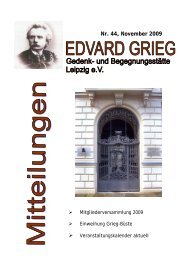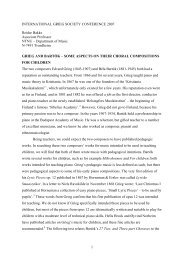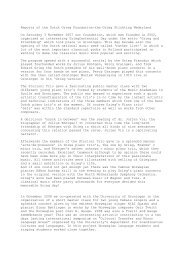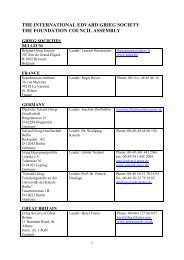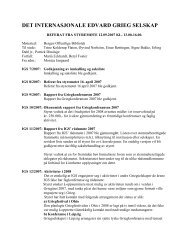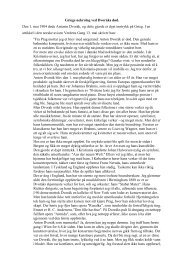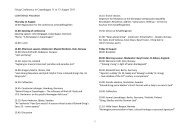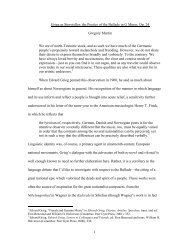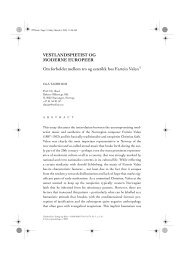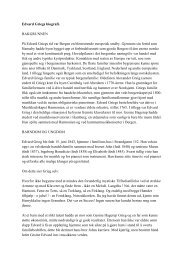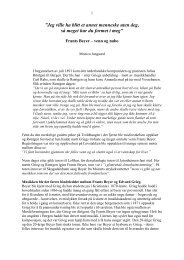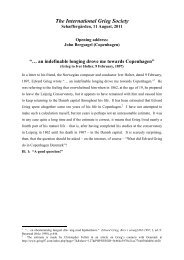Gregory Martin - paper 2009 - Grieg Society
Gregory Martin - paper 2009 - Grieg Society
Gregory Martin - paper 2009 - Grieg Society
Create successful ePaper yourself
Turn your PDF publications into a flip-book with our unique Google optimized e-Paper software.
<strong>Grieg</strong>‘s Untold Triumph: The Piano Concerto, Gustav Mahler,and a New Approach to the Sonata Aestheticby<strong>Gregory</strong> <strong>Martin</strong>There's no time for elaborate introductions today, but I'd like to start with a (very) brief survey of theway in which the concerto, especially the piano concerto, developed from the three separate andindependent movement-structure of, say, Mozart to a more unified conception during the course ofthe 19th-century. Through the early canonic examples of Beethoven (nos. 4 and 5), which elidemovements two and three, and the Weber Konzertstücke, we arrive at the Mendelssohn concerti –works that solved the tonal dilemma of the double-exposition model while simultaneously eliding allthree movements. The Schumann concerto – the example which has earned the greatest number ofcomparisons with <strong>Grieg</strong>'s effort – replaces a true slow middle movement with an intermezzo (and inso doing strikes a resemblance with Beethoven's Waldstein sonata); there are other concertino works bySchumann which further contribute to the progression toward a more unified design. And if the firstmovement of his piano concerto had not been originally conceived as an independent fantasy, perhapsthe final product would have been a different thing altogether. The Liszt concerti likewise decay thedouble-bar as barrier. The attacca into the finale notwithstanding, the <strong>Grieg</strong> concerto, with its full stopat the end of each movement, hardly seems to contribute much to this process. It is my intention,however, to propose a new way of listening to this warhorse, and a new, commensurate way ofinterpreting the sonata aesthetic within it.
I have long felt that in his concerto – as well as in the three violin sonatas – <strong>Grieg</strong>'s efforts to build alarge structure take on the shape of that most <strong>Grieg</strong>ian of designs: ternary form. In other words, these3-movement pieces are macrocosmic representatives of his approach to ABA layout. He wasobviously very comfortable in this form, and it will be argued that the structural choices he madewhen working in this capacity had greater implications when he turned to multi-movementcomposition. That is, the first and third movements act as something of parallel statements, contrastedby the second movement's affective differences, though while often utilizing aspects of the outermovements' materials. This is not too unlike the manner in which Liszt extended a broad sonatadesign across the different movements of his B minor sonata (and indeed, given the nature of <strong>Grieg</strong>'srelationship with Liszt it is not too much to suppose that this hadn't occurred to <strong>Grieg</strong> himself).Let's first briefly examine the relationship between the outer movements and the second movement.The piano enters in the outer two almost immediately with bravura cadenza-like passages, while in themiddle movement the orchestra is given the entire exposition. When the piano does enter, though, it iswith a descending cascade and a consequent ecstatic motion upward designed to echo the traversal ofthe keyboard demonstrated in the piano entrance of the outer movements. The link is strengthenedwhen the melodic and harmonic parallels are laid bare, as in Ex. 1:
The <strong>Grieg</strong> motive – or derivations from it, for remember that <strong>Grieg</strong> came from a time before gesturalshape had been robbed of its motivic significance – in the pianistic flourishes of all three movementsfurther tie the overall structure together, as does the use of dance topics. While both of the outermovements demonstrate the use of folk dances, the middle movement signals a topical union in itssarabande quality. It is so rarely played like one, but the slightest study indicates the dominance of beattwo within its slow triple meter and the hemiola implications at its cadence points. Furthermore, thechromatic mediant restatement of the piano entrance at m. 39 (F-flat major in the key of D-flat major)mirrors the D-flat major tonality of the second movement in the global landscape of A minor. Andthe harp-like piano arpeggios in the middle section parallel those in the development of the firstmovement as well as those that occupy the more developmental passages in the finale; at each instant,the development consists primarily of sequential reiterations of the main thematic material. Again,such use of gesture (the harp) is vital in <strong>Grieg</strong>'s music, and it is significant to note that this figure andsound occurs at the same formal juncture in each movement, and that it is in tendem with sustained ortremolo strings and the flute taking a leading melodic role in each case. Such relationships contributegreatly to the sense of overall identity.
For the remainder of our discussion on the broad ternary design on display in the concerto, we willconcentrate on the parallels between the first and third movements. While they do not appear to usethe same thematic material (other than the <strong>Grieg</strong> motive in the piano passages noted before), there isan aspect of thematic transformation across them that ties the two movements together: the melodicfragment that closes the first theme – marked by the introduction of the triplet figure into the contextof a thus far purely duple music – evolves via the lyric interlude between the first movement‘s primaryand secondary themes to become the lyrical F major episode of the finale, Ex. 2:When we examine aspects of form, structure, topic, and affect, the similarities between the outermovements become rather uncanny. Both begin with an opening flourish that spans the entirecompass of the piano, and then initiate the movement proper with two theme-groups in the tonic of Aminor. In each movement, the first theme evinces folk-like rhythms in duple meter and is replete withthirds in the melody, while the second primary theme (also folk-like) is of a more scherzando quality,with the primary accent on the off-beat. In both movements, it is this second of the primary themes
that is charged with moving the tonality from the tonic to the new key area (C major both times).Each movement introduces the Mixolydian flat-seventh scale-degree in the second theme as a deviceto mark its more lyrical nature; it was, of course, this characteristic's incarnation in the coda of thefinale that so caught Liszt's imagination during his first read-through of the concerto in Rome, atwhich point he jumped up and exclaimed ―G-natural, G-natural not G-sharp!‖There is a common sense of ratio between the two outer movements, with the finale's large bi-partitecoda balancing the cadenza of the opening movement. The F major theme in the finale isproportionally equivalent to the development section in a sonata design; its closed and self-containednature, redolent of the Romantic character piece, suggests a kinship with the ―Im Legendenton‖section of Schumann's Fantasy, Op. 17. The outer movements also bring a mutual approach toframing. In the first movement, the opening flourish returns at the end, while in the finale theintroductory arpeggio/scale figure is given an heroic, valedictory persona in the last pages of the work.This sectional parallelism between the first and third movements necessitates a certain kind of layout,one that would allow more deliberate formal demarcation, especially vis-à-vis the sonata form of thefirst movement. The aesthetic decision that accompanied this was absolutely a conscious one: indeed,it was something <strong>Grieg</strong> acknowledged importing into the G minor string quartet in a letter to FrantsBeyer in 1884:You know that in my larger works – in order to enhance the architectonic effect and toemphasize the contrast of the themes – I have the habit or weakness or whatever I should call it of
concluding in the home key before the second theme is introduced rather than, like most composers,using a transitional passage that leads imperceptibly to that theme. The same pattern occurs again afterthe return of the first theme following the development section. (Letters, 38)In other words, why – when the principal governing agent of the sonata design is the dynamic ortension created by the opposition of tonalities and themes – would one mollify those so-importantcontrasts by composing transitions that ease one aspect into the other? This approach of courseanswers a number of criticisms leveled at <strong>Grieg</strong>‘s handling of larger forms, but – more importantly – Ithink that <strong>Grieg</strong> may have found such full stops to signify a markedly Nordic element, a notionsupported by a look at the three violin sonatas, their compositional contexts, and <strong>Grieg</strong>‘s descriptionsof them.The first sonata was written during his residency in Denmark during the mid-1860s, of which hewrote:Then came the Copenhagen period, when I – in association with Nordic art and Nordic artists,in the process of studying Nordic sagas and Nordic folk life – began to understand and to findmyself. ……This was in 1864-65. There in Copenhagen, in daily association with Nordraak andother young people who were enthusiastic about everything Scandinavian, in a short time Iwrote many songs, Humoresques op. 6, Sonata op. 7, and Sonata op. 8. (Letters, 305-6)
As with the last movement of the Op. 7 piano sonata 1 , both sonata-design movements of Op. 8 firmlyarticulate the end of the first theme, cadencing in the tonic of F major, and then initiating thesecondary theme in A minor:Ex 3a: Sonata in F, Op. 8, Movement 1 exposition, end of first theme into secondary themeEx 3b: Sonata in F, Op. 8, Movement 3 exposition, end of first theme into secondary themeThe Finale also displays noteworthy early examples of topically Norwegian patterns and textures thatwere to figure prominently in <strong>Grieg</strong>‘s later work, particularly the scherzando passage that anticipatesthe ―March of the Dwarves‖ and the open fifth drones with Lydian-inflected grace notes that would1 The first movement has a clear half-cadence.
later make a more confident appearance in Pictures of Folk-life, Op. 19. Of this <strong>Grieg</strong> later wrote: ―thisuse of G# in the key of D – was the thing that drove me wild … The augmented fourth also occurs inpeasant folk songs. It is a holdover from one or another of the old scales. But which one?‖ (Letters,349)Despite such obvious Norwegian inspirations in Op. 8, it was Op. 13 that <strong>Grieg</strong> described as having―nationalist tendencies.‖ He surely meant this to apply to structural aspects as well as thematic ones;again, we notice distinct cadences between themes:Ex 4: Sonata in G, Op. 13, Movement 1 recapitulation, end of first theme into secondary themeBy contrast, the C minor sonata and its ―wider horizons‖ – written two years before the so-called‗Cosmopolitan Credo‘ of 1889 – uses a shared accompanimental figure to bridge the themes:
Ex 5: Sonata in Cm, Op. 45, Movement 1, primary theme into secondary themeFurthermore, in both of the first two sonatas, the end of the Exposition is marked by a definitivecadence, while in Op. 45 the transition into the development is done without formal demarcation:Ex 6: Sonata in Cm, Op. 45, Movement 1, transition from Exposition into Development
<strong>Grieg</strong> noted a parallel between such sudden juxtapositions (as opposed to smooth transitions) and theNorwegian character in his famous letter-insert to Henry Finck, writing to the American musicologistthatthe folksong is a musical reflection of the innermost soul of the people. . . . The basic featureof the Norwegian folk song … is a deep sense of melancholy that can suddenly change intowild, unbridled humor. Mysterious gloom and unrestrained wildness — these are thecontrasting elements in the Norwegian folk song (Letters, 231)In his discussion of the E minor piano sonata‘s second movement, David Monrad Johansen foundsuch an approach to form to be reflective of Norwegian landscape:The principle of form, the chief features of which are precisely surprise, alternation, rapidlychanging pictures which yet are held together and comprehended in one general aspect, showsthe extreme closeness with which <strong>Grieg</strong>‘s art is bound to the scenes and spirit of hishomeland, to the mountains and fjords of the Westland. (72)Indeed, the relationship between this quality and the Norwegian landscape was something <strong>Grieg</strong>himself hinted at in the previously-cited letter to Beyer regarding the quartet performance in Rome:―One‘s own inner life of the soul expressed in the natural scenery of Hardanger.‖ (Letters, 39) Theconcerto was not written in Hardanger, however, but – like those pieces written during his artistic
awakening as discussed earlier – in Denmark, and in its sonata approach may be found the influenceof a particularly noteworthy mentor from that period: Hans Christian Andersen.―When I went to Copenhagen in 1863,‖ <strong>Grieg</strong> wrote, ―I began to breathe Nordic air and got incontact with Danish poets, both personally and musically. This group also included Hans ChristianAndersen, the writer of fairytales.‖ (Letters, 230) Writing on the 100 th anniversary of Andersen‗s birth,he opined that a ―longing for the child – the lost child! – in ourselves is the hidden spring inAndersen‘s works, for the sound of which we and the whole world are constantly listening.‖ (Letters,163) <strong>Grieg</strong>‘s diaries are dotted with quotes and exclamations from Andersen, he repeatedly comparedthe reception of Mozart with Andersen‘s Snow Queen, and in 1889 he told an English news<strong>paper</strong> that―one of the first who understood how to estimate his work was the great Danish poet.‖ (MonradJohansen, 55) A year before he composed the Concerto, Edvard and Nina Hagerup were married;among the items <strong>Grieg</strong> requested his mother to send to their new home in Christiania (Oslo) wasAndersen‘s works in twelve volumes; the composer later maintained that ―many will do as I intend todo: we will read these books more than once.‖ (Letters, 163) There can be little argument, then, thatAndersen was an important source of encouragement for <strong>Grieg</strong> during the 1860s, the time when hewas surrounding himself with fellow Scandinavians in search of an authentic voice. Given <strong>Grieg</strong>‘ssensitivity to language and literature, as captured in his later correspondences with writers like Ibsen,Bjørnson, and Garborg, as well as his affinity to Robert Schumann – a composer who took profoundinspiration from literary models, and about whom <strong>Grieg</strong> wrote a remarkably insightful article for The
Century Monthly Illustrated Magazine in 1893 2 – it seems unlikely that his compositions would not beaffected by aspects, particularly structural ones, of the literature he loved. On such grounds, I‘d like topropose that during those crucial formative years in Copenhagen, surrounded by his Nordic brethrenof which Andersen was so obviously a focal point, <strong>Grieg</strong> may have found in the montage-like mannerof the Danish master‘s writings – a literary parallel to the author‘s passion for collage creation – adecidedly Nordic formal construct, a model for his emerging musical voice and one redolent, perhaps,as Monrad Johansen observed, of the landscape he loved so much (Ex. 7). In his biography of HansChristian Andersen, Jens Andersen – no relation to the author – writes: ―Andersen was amazinglyclever at cutting and pasting, not only with scissors and glue pot but also with his pen. We find literarymontages everywhere in his novels, plays, poems, and fairy tales.‖ (501) This manner of suddenmovement from one perspective, narrative, or authorial voice into another without transition is exactlythe kind of musical construction we have observed in the music most marked by <strong>Grieg</strong> as having beencomposed in a way reflective of his Norwegian identity. When the young composer brought his highlydemarcated Humoresques to Neils Gade, the elder master asked ―Tell me <strong>Grieg</strong>, is this stuff supposed tobe Norwegian?‖ The young composer replied ―Yes, Herr Professor, it is.‖ (Letters, 416)In the concerto, particularly the sonata design first movement, this technique is perfected intothe side-by-side placement of ―theme blocks.‖ In this schema, the second primary theme is charged2 <strong>Grieg</strong>’s closeness to Schumann’s music is expressed in no uncertain terms in his concert programs in theseimportant years: a recital in Karlshamn, Sweden towards the end of his time at Leipzig included Kreisleriana, and inhis first recital in Bergen after graduating from the conservatory (21 May 1862), he played the piano in the Quartet,Op. 47.
with moving to the new key, rather than a transitional passage using pre-established motivic material.When mapped out, the exposition looks something like Ex. 8:Opening First Primary Second Primary Lyric Interlude SecondaryFlourish Theme (Am) Theme (Am) (V7/C major) Theme (C)mm. 1-6 mm. 7-30 mm. 31-42 mm. 43-48 mm. 49-72This arrangement allows <strong>Grieg</strong> to construct outer movements which bear the markedly similarstructural delineations mentioned previously, parallels that become especially obvious when placedside by side, as in Ex. 9:
Such a layout leads our attention to a subtle, more subcutaneous aspect of <strong>Grieg</strong>‘s global ABA plan:the use of common accompanimental or tail figures. Even if <strong>Grieg</strong> had truly never learned a thing atthat ―damned Leipzig conservatory‖ (a sentiment that is obviously suspect), when he returned toBergen in 1862 and initiated his private course of study in the classical masters – a practice begun inGermany: ―What Reinecke failed to teach me I tried to pick up from Mozart and Beethoven, whosequartets I diligently studied on my own initiative‖ (Diaries, 83) – he would likely have found, as Czernynoted in his study on the Beethoven piano works, that ―in Beethoven's works [and we could easilyinsert any number of other composers here, not least of which Haydn] we often find that he groundsthe structure of his pieces on single and apparently unimportant notes.‖ This is exactly what <strong>Grieg</strong>does to link and unify his theme blocks across the first and third movements, and this may be themost significant – because most fundamental to the structure – of the parallelism joining the outermovements.For example, joining the two primary themes are the half-cadential gestures in the first and thirdmovements, respectively (Ex. 10):
In both of these movements, the contrasting secondary theme is introduced by a tag idea in which thenew material is lead into by a scalar descent in the bass (Ex. 11):Within the opening movement‘s second theme, phrases are punctuated and joined by a figure derivedfrom the tag that had been used to link the two primary themes (Ex 12),while the two principal themes of the finale are unified by a common bass gesture (Ex. 13):
If <strong>Grieg</strong> found in such a design replete with formal demarcations a distinctly Nordic voice, it must beadmitted that the next outstanding exponent of this expression – Jean Sibelius – turned instead to thegradual development of thematic material as a musical representation of great distance and glacialmovement, the vast reaches of the Finnish topography. Rather ironically, the architectural aestheticespoused by <strong>Grieg</strong> turned out to be one adopted in the later 19 th -century by German composers. Aparticularly recognizable example occurs in the opening sonata-form movement of Gustav Mahler‘ssixth symphony.As in <strong>Grieg</strong>‘s concerto, the first theme group is in A minor and is responsible for negotiating thearrival of the secondary theme, though on its own terms and without a true modulation. At the end ofthis passage (m. 76, Ex. 14), the global dominant serves as a point of departure into the new theme (inF major) without ever really transitioning at all. This layout is, of course, analogous to the techniquewhich <strong>Grieg</strong> uses in his concerto. The size of the theme blocks in Mahler‘s work are necessarily biggerand the number of them fewer because of the notably different scope with which the two men wereworking, but the philosophy is consistent: the arrival of themes without having been guided there bythe hand of already familiar material.―Artists like Bach and Beethoven erected churches and temples on the heights,‖ <strong>Grieg</strong> wrote, ―I onlywanted … to build dwellings for men in which they might feel happy and at home.‖ Edvard <strong>Grieg</strong>‘sdwellings are houses with room leading into room, houses without than the long, elaborate hallways ofBeethoven and Brahms. In the piano concerto, a large scale application of the rhetoric he employed so
illiantly in his most intimate confessions – the ternary form – is employed to construct a work ofpalatial proportions. With this majestic utterance, <strong>Grieg</strong> built not only a timeless masterpiece, but avery fine mansion, indeed.



